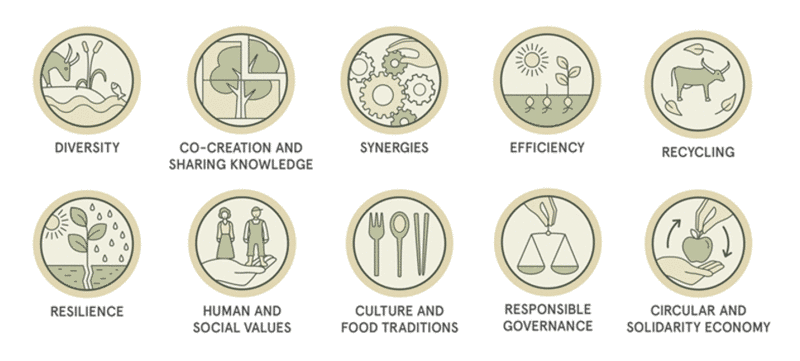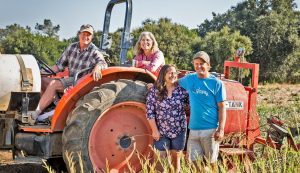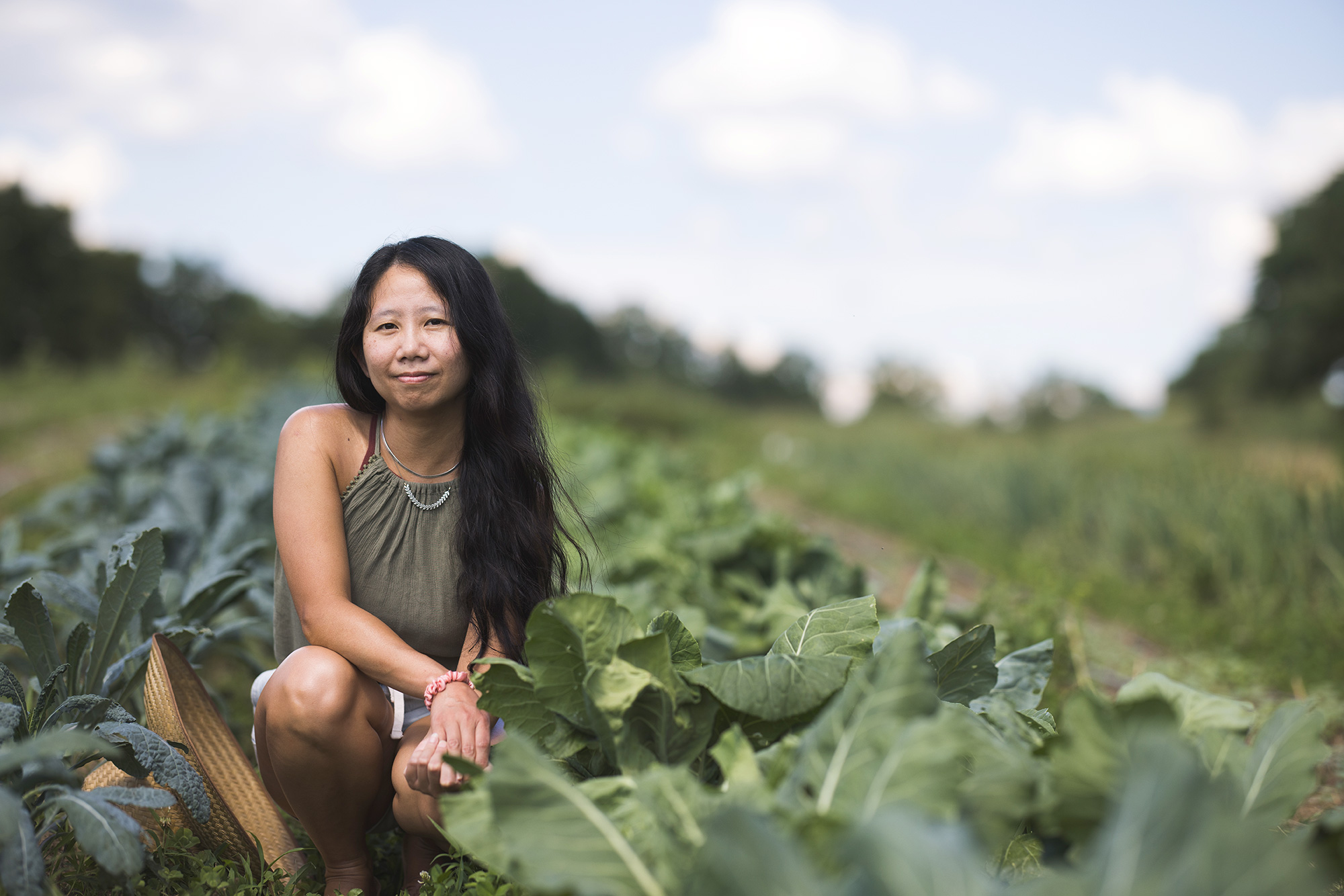Holistic system offers healthy, ecological, and just alternative to the damage of industrial agriculture
Organic and regenerative agriculture systems are considered the best alternatives to industrial agriculture with its environmentally damaging and health threatening practices like toxic pesticides and GMOs. But another, more holistic agriculture system—agroecology—is gaining greater recognition in the U.S. after successful adoption in other parts of the world for many years.
Agroecology: science, practice, and movement

10 elements of agroecology
Agroecology’s increased standing in the U.S. was the focus of a recent paper, “Momentum for agroecology in the USA,” published in the July edition of the journal Nature Food.
“Agroecology is a science, a practice, and a movement with these three spheres being inseparable,” says Theresa Ong, Assistant Professor of Environmental Studies, Dartmouth University, and co-author of the paper.
According to Ong, the science aims to understand the food system as a whole and to create more sustainability from ecological, social, and political perspectives. The practice is what farmers do to steward the land and sustain the planet and people. The movement is comprised of farmers, farm workers, advocacy groups, academics, consumers, and others trying to force change in food systems from the industrial model to more sustainable systems.
Miguel Altieri, an agronomist and entomologist who is recognized as one of the leaders in the agroecology movement and has written extensively about agroecology, says agroecology is “a science that is based on modern ecological science and agronomy, but also captures traditional knowledge that has been in place for thousands of years in developing countries.”
Roots in Latin America
Agroecology has its roots in Latin America spearheaded by the work of La Via Campesina, an international organization supporting peasants and small and medium-size farmers that advocates for food sovereignty based on agroecological practices.
“A lot of important initial work from all three spheres of agroecology—science, practice, and movement—was done in Latin America,” Ong says.
For example, Brazil has a national law on agroecology that requires 30% of food produced by smallholder farmers go to school lunch programs; the Brazilian government pays the farmers to produce that food.
“Most of this food is produced agroecologically, so the implications that has in terms of better health is huge,” Altieri says.
Other agroecology initiatives have been implemented in Peru, Chile, Columbia, and Argentina.
“There are many, many, examples of agroecological initiatives dispersed throughout Latin America,” Altieri says.
In Mexico, agroecological researchers are working with small scale citrus farmers to transition away from agrochemicals such as glyphosate in favor of agroecological methods.
Beyond organic and regenerative
Agroecology can encompass organic and regenerative practices, such as prohibiting the use of synthetic inputs, building soil health, and supporting biodiversity.
“In terms of the practices, we can see that the best organic farms, in terms of their ecological processes, are very agroecological,” says Antonio Roman-Alcala, Assistant Professor, Department of Anthropology, Geography & Environmental Studies at California State University and co-author of the Nature Food paper.
But agroecology’s focus extends beyond the practices, “taking into account the social aspects that must be addressed for a sustainable and equitable food system,” according to the United Nations Food and Agriculture Organization (FAO).
“The criticism for the organic and regenerative movements is that they’ve lost a lot of the initial social welfare components of their charge,” Ong says. “In the U.S., organic has a very explicit definition that’s primarily about production and practices. There’s no mandate for any kind of social welfare or political change.”
Still, Ong sees opportunities for building coalitions with the organic and regenerative movements.
“What we talk a lot about in the paper is the centrality of coalition building in agroecology, finding ways that we can work together in creating more sustainable food systems and trying to create momentum by seeing where the visions align,” she says.
Agroecology in the U.S.
In the U.S. the growing impetus for agroecology is the damage caused by industrial, corporate-driven agriculture, which dominates food production. As the Nature Food paper states, this system “poses a major threat to our planet’s health, contributing to climate change, biodiversity loss and food insecurity, which is known as the triple threat to humanity.”
As a result, there is an urgent need to transform food production in the U.S. and worldwide. Ong, Altieri, and others argue that agroecology offers a viable solution.
Agroecology’s international standing increased with a 2019 report by the FAO’s High-Level Panel of Experts of the Committee on World Food Security. The report recognized agroecology’s potential contributions to formulating transitions towards sustainable food systems.
“We’re seeing this first wave of international recognition of agroecology, and more governments actually create policies focused on agroecology in ways that we haven’t seen before,” Ong says. “The international recognition is forcing the hand of the U.S., which has been slower to recognize agroecology.”
The U.S. agroecology movement got a boost when the U.S. Department of Agriculture asked agroecologists to convene a U.S. Agroecology Summit in 2023. The summit brought together 100 stakeholders in the food system to discuss promoting agroecology research in the U.S.
Agroecology programs are emerging at U.S. colleges and universities. For years, the University of California at Sant Cruz’s Center for Agroecology was the only program. Now there is the Agroecology Center at Florida A&M and most recently the Institute for Agroecology at the University of Vermont. There are also more than 80 academic degree programs in the U.S. with coursework on agroecology.
As a further sign of the recognition of agroecology in the U.S., the Pesticide Action Network recently changed their name to Pesticide Action & Agroecology Network.
“The right to define, produce, and access healthy food”

Full Belly Farm partners, from left: Paul Rivers, Judith Redmond (no longer active), Dru Rivers, and Amon Rivers.
Full Belly Farm, a long-established certified organic farm in California’s Capay Valley, is a good example of an agroecological farm in the U.S. The farm grows more than 100 organic vegetables, fruits, and nuts on 400 acres in California’s Capay Valley. The farm focuses on producing nourishing foods, building soil health, and crop diversity and caring for the environment. But Full Belly’s commitment goes beyond the farm to the greater community. They provide fresh organic foods through their Community Supported Agriculture program. They help build food sovereignty by supporting the growth of other organic farms in their region. They provide jobs to people in the community and ensure their workers, some of whom have worked on the farm for 30 years, have stable employment and are treated fairly.
“We love to think of ourselves as beyond organic in a lot of ways,” says Full Belly Farm co-owner Dru Rivers. “Agroecology is not about just an isolated farm; it’s really about trying to have a healthy community.”
Full Belly Farm is building food sovereignty, a critical goal of agroecology, in its region. Ong says food sovereignty is “the right to define, produce, and access healthy food that is culturally appropriate and preserves the ways of life of farmers.”
Altieri contrasts food sovereignty with food security. “Iowa is food secure, but it’s not food sovereign because it has to import all its food,” he says. “Food sovereignty means that you produce all your food, and you satisfy the needs of your local populations with the systems that you have in place.”
What is the potential of agroecology? “I hold great hope for agroecology in terms of being a leader in solutions for food systems transformation,” Ong says. “Whether you’re a consumer, a farmer, or a farm worker, everyone in society has some relation to food, and agroecology can show us how we are all connected in the food system, and how reliant we are on each other to make that system work for all of us.”





